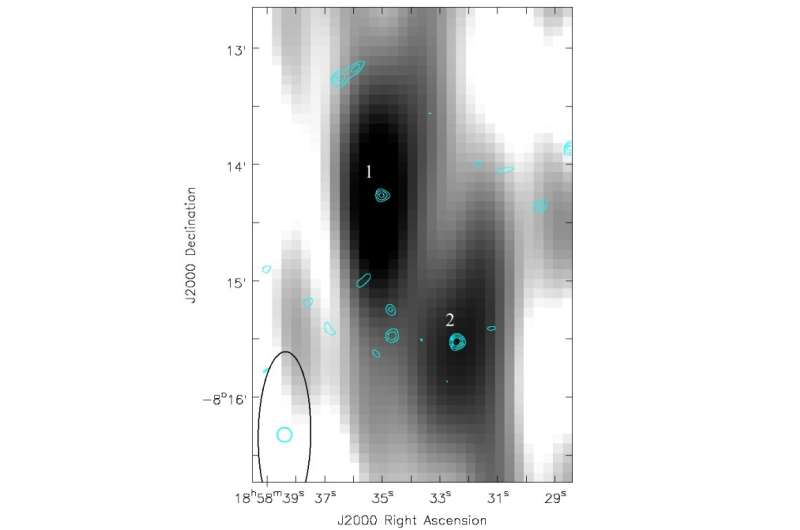April 13, 2022 report
Astronomers inspect outburst of X-ray binary Swift J1858.6−0814

Using the MeerKAT radio telescope and the Arcminute Microkelvin Imager–Large Array (AMI-LA), astronomers have conducted a radio monitoring campaign of the outburst of a recently discovered X-ray binary known as Swift J1858.6−0814. Results of these observations, presented April 4 on arXiv.org, shed more light into the nature of this source.
X-ray binaries (XRBs) consist of a normal star or a white dwarf transferring mass onto a compact neutron star or a black hole. Most black hole XRBs and some neutron star XRBs show transient events that are characterized by outbursts in the X-ray band.
Swift J1858.6−0814 (or J1858 for short) is a neutron star XRB that was first identified by NASA's Swift spacecraft during an outburst in October 2018. The system is located some 41,700 light years away, and its orbital period is estimated to be approximately 0.83 days.
In order to better understand the nature and behavior of J1858, a team of astronomers led by Lauren Rhodes of the University of Oxford, UK, has commenced radio observations of this source. The MeerKAT observations were made at a central frequency of 1.28 GHz with a bandwidth of 856 MHz split into 4,096 channels. When it comes to AMI-LA, the observations were made at 15.5 GHz with a bandwidth of 5 GHz, binned to 8 channels.
"We present the results of our long term radio monitoring campaign at 1.3GHz (MeerKAT) and 15.5 GHz (Arcminute Microkelvin Imager–Large Array, AMI-LA) for the outburst of the recently discovered neutron star X-ray binary Swift J1858.6−0814," the researchers wrote in the paper.
As a result of the monitoring campaign, the team has observed self-absorbed radio emission from Swift J1858.6−0814 and recorded two radio flares. This is consistent with a quasi-steady compact jet as expected in the hard X-ray spectral state. The radio light curves of the source showcase little significant long term variability.
By analyzing one of the flares, the researchers managed to determine the magnetic field and minimum energy of J1858's jet. The magnetic field was found to be at a level of 2.0 G, while the energy was estimated to be around 50 undecillion erg. The astronomers added that at the peak of the flare, the emission region size was measured to be some 100 million kilometers.
Based on the results, the authors of the paper concluded that J1858 appears to be a very radio-luminous atoll-type or faint Z source neutron star binary. The so-called atoll sources share some characteristics with black hole XRBs as they have similar X-ray spectra and timing properties. However, they differ in their radio properties where atoll sources are 27 times less radio luminous. When it comes to Z sources, they evolve much more quickly than those of atoll-type. In general, they are more X-ray and radio luminous than atoll sources.
The astronomers underlined that despite the wealth of observations and data, they were unable to definitively determine whether J1858 is an atoll or Z source. Further studies are required in order to correctly classify this system.
More information: L. Rhodes et al, Long term radio monitoring of the neutron star X-ray binary Swift J1858.6-0814. arXiv:2204.01598v1 [astro-ph.HE], arxiv.org/abs/2204.01598
© 2022 Science X Network





















